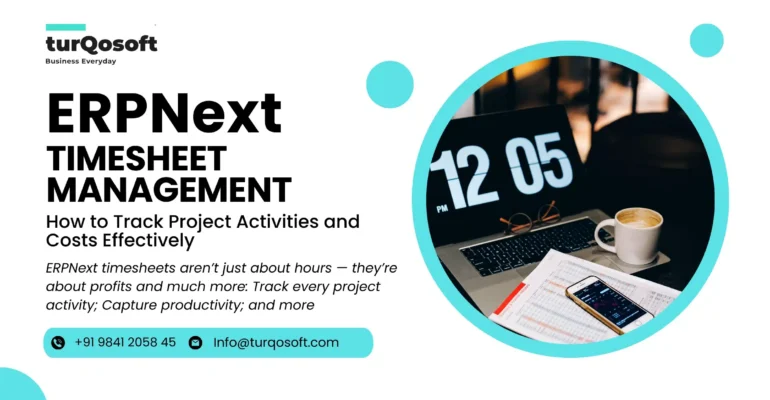ERPNext Timesheet Management: How to Track Project Activities and Costs Effectively

ERPNext Timesheet Management: How to Track Project Activities and Costs Effectively
When businesses start using ERPNext, one of the most underrated but powerful features they discover is Timesheet Management.
It’s not just about logging hours. Timesheets in ERPNext help you:
a) Track every project activity
b) Capture employee productivity
c) Calculate costs vs. billing automatically
d) Improve project profitability
In this article, we’ll break down how ERPNext timesheet management works, why it matters, and how to use it effectively.
Why Timesheet Management Matters in ERPNext
Every business that works on projects — whether consulting, IT services, construction, or manufacturing — knows the struggle of tracking time.
-
Teams often log hours in Excel sheets or, worse, not at all.
-
Project managers find it hard to connect activities with costs.
-
Billing clients becomes guesswork instead of accurate reporting.
This is where ERPNext timesheets shine. By linking employee hours directly with projects, tasks, and costs, ERPNext turns time tracking into a real business advantage.
Key Features of ERPNext Timesheets
ERPNext goes beyond simple time logging. Some of its most useful features include:
-
Activity Logging → Employees can enter hours against specific tasks or activities.
-
Project Tracking → Hours are linked to projects, making cost allocation easy.
-
Billing & Costing Rates → ERPNext automatically calculates how much time costs you vs. what you can bill clients.
-
Payroll & Invoicing Integration → Timesheets flow into payroll for salaries and into invoices for billing.
This makes ERPNext a complete timesheet management solution for both small businesses and enterprises.
Step-by-Step Guide to Managing Timesheets in ERPNext
Step 1 – Setting Up Activities and Projects
Before you log hours, you need structure.
-
Define your projects in ERPNext.
-
Create activities linked to tasks (e.g., “Design Work,” “Testing,” “Client Review”).
This ensures employees know where to log their time.
Step 2 – Logging Hours in Timesheets
Employees can create timesheet entries for each activity. They’ll fill in:
-
Activity type
-
From/To time or total hours
-
Project and task link
For Example: 2 hours logged under “Bug Fixing – Project A.”
Step 3 – Calculating Cost and Billing Rates
ERPNext automatically applies:
-
Costing Rate → Internal cost of the employee’s time
-
Billing Rate → How much you charge the client
This helps you see profit margins per project in real-time.
Step 4 – Submitting and Approving Timesheets
To maintain accuracy, timesheets usually go through an approval flow:
-
Draft → Employee logs hours
-
Submitted → Sent for review
-
Approved → Locked in for payroll/invoicing
This ensures accountability and prevents fake or inflated entries.
Benefits of Using ERPNext for Timesheet Management
When implemented correctly, timesheets deliver measurable business value:
-
Accurate Cost Control — You know exactly where money is spent.
-
Transparent Client Billing — No disputes, just detailed reports.
-
Improved Project Profitability — Cost vs. billing is visible at every step.
-
Employee Accountability — Teams are more productive when their time is tracked.
Common Mistakes Businesses Make With Timesheets
Even with ERPNext, businesses can run into trouble if they:
-
Forget to train employees on accurate time logging
-
Mix personal vs. project hours in one sheet
-
Ignore timesheet approval workflows
-
Log hours without linking them to activities or projects
These mistakes make reports unreliable and reduce adoption.
Tips to Get the Most Out of ERPNext Timesheets
Here are some best practices we’ve seen work for clients:
-
Train your employees early → Show them how timesheets benefit them (not just management).
-
Standardize activity types → Keep categories simple and consistent across projects.
-
Use reports regularly → Review project cost reports weekly, not at the end.
-
Integrate with payroll and invoicing → Save hours of manual reconciliation.
When timesheets are used consistently, ERPNext becomes a powerful cost and profitability dashboard.
Conclusion – Turning Timesheets Into Insights
At first glance, timesheets might look like just another layer of admin work. But in ERPNext, they become something far more powerful — a tool to measure performance, control costs, improve billing accuracy, and ultimately boost project profitability.
Used consistently, ERPNext Timesheets transform from a simple log of hours into a strategic dashboard for business growth.
Stay connected with us on LinkedIn, YouTube, Facebook, Twitter, Pinterest, or Instagram to receive regular updates on CRM, ERP and other pertinent topics.
PC: Canva


